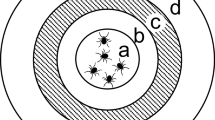Abstract
Adult Hyalomma truncatum ticks with uncovered and foil-covered eyes were exposed to an upright-positioned rectangle as a target giving a luminance contrast ratio of 5:1 at a sun-simulating radiation. The transmission rate of the foil was less than 0.003%. Significantly (p≤0.05) more locomotorally active ticks with uncovered eyes (36.6%) responded to the target than ticks with foil-covered eyes (7.3%). When the rectangle was illuminated by monochromatic light at wavelengths ranging between 420 and 648 nm, the target induced a positive scototaxis in ticks with uncovered eyes regardless of the wavelength range. In contrast, ticks with covered eyes did not exhibita positive scototaxis at wavelength ranges of 553–585 and 608–648 nm and very few ticks responded only to other wavelength ranges. The results indicate that the eyes are the only or at least the most essential sense organs in the visual system of adult H. truncatum ticks.
Similar content being viewed by others
REFERENCES
Bergermann, S. 1996. Zur Morphologie und strukturellen Organisation sowie zur Funktion der augen männlicher und weiblicher Adultzecken von Hyalomma truncatum (Acari: Parasitiformes: Ixodida: Ixodidae). Thesis, University of Munich.
Carroll, J.F. and Pickens, L.G. 1987. Spectral sensitivity to light of two species of ticks (Acarina: Ixodidae). Ann. Entomol. Soc. Am. 80: 256–262.
El Shoura, S.M. 1988. Fine structure of the sight organs in the tick Hyalomma (Hyalomma) dromedarii (Ixodoidea: Ixodidae). Exp. Appl. Acarol. 4: 109–116.
Gothe, R., Göbel, E. and Schöl, H. 1990. On the morphology and organization of the eye of unfed adult Rhipicephalus evertsi mimeticus (Acari: Ixodidae). Parasitol. Res. 76: 428–434.
Kaltenrieder, M. 1989. Spektrale und absolute Empfindlichkeit, sehfeld und Skototaxis der Zeckenarten Hyalomma dromedarii und Amblyomma variegatum. Vergleichende sinnesphysiologische Untersuchungen am optischen System zweier Zeckenarten. Thesis, University of Neuchâtel.
Kaltenrieder, M., Labhart, T. and Hess, E. 1989. Spectral sensitivity, absolute threshold, and visual field of two tick species, Hyalomma dromedarii and Amblyomma variegatum. J. Comp. Physiol. A 165: 155–164.
Koch, B. 1989. Zur sensitivität von Argas (Persicargas) walkerae auf optische Strahlung sowie zur Lokalisation und Organisation lichtperzipierender oder-durchlässiger Areale des Integumentes. Thesis, University of Munich.
Kopp, K. and Gothe, R. 1995a. Hyalomma truncatum (Acari; Ixodidae): investigations into the scototaxis of unfed adult ticks. Exp. Appl. Acarol. 19: 53–64.
Kopp, K. and Gothe, R. 1995b. Hyalomma truncatum (Acari; Ixodidae): evidence for the inability of adult ticks to discriminate between colours. Exp. Appl. Acarol. 19: 155–162.
Kupressova, V.B., Trovimov, L.G. and Romanenko, W.N. 1977. Die Rolle der Sicht für die Orientierung des Imago Hyalomma asiaticum P. Sch. et E. Schl. Forschungsstelle für das verhalten von Tieren, Moskau, Nanka, 172–173 (translation from Russian into German).
Leonovich, S.A. 1979. Über die Ultrastruktur des Auges bei der ixodiden Zecke Hyalomma asiaticum (translation from Russian into German). Zool. Zh. 58: 437–439.
Leonovich, S.A. 1986. Das Orientierungsverhalten der Ixodoida-Zecke Hyalomma asiaticum in Wüstenverhältnissen (translation from Russian into German). Parasitologiya 20: 431–439.
Leuterer, G. and Gothe, R. 1991. On the reaction of adult Rhipicephalus evertsi mimeticus and Hyalomma truncatum to horizontally incidenting optical radiation of various wavelength ranges and different irradiances and to optical radiation of a sun-simulating wavelength spectrum. Parasitol. Res. 77: 353–358.
Phillis, W.A. and Cromroy, H.L. 1977. The microanatomy of the eye of Amblyomma americanum (Acari: Ixodidae) and resultant implications of its structure. J. Med. Entomol. 13: 685–698.
Werder, J. 1992. Reiz-Reaktionsbeziehungen zwischen Adultzecken von Hyalomma truncatum und Rhipicephalus evertsi mimeticus (Ixodoidea: Ixodidae) und vertikal einfallender eng-und breitbandiger optischer Strahlung sowie einem zur Strahlungsquelle ausgerichteten CO2-Gradienten. Thesis, University of Munich.
Werder, J. and Gothe, R. 1993. Hyalomma truncatum and Rhipicephalus evertsi mimeticus (Ixodoidea: Ixodidae): reactions of adult ticks to vertically incident narrow-and wideband optical radiation with and without the influence of a CO2-gradient. Exp. Appl. Acarol. 17: 489–501.
Wilson, M.L., Dykstra, E.A. and Schmidt, B.A. 1993. Temperature-and humidity-dependent longevity of unfed adult Hyalomma truncatum (Acari: Ixodidae). J. Med. Entomol. 30: 467–471.
Author information
Authors and Affiliations
Rights and permissions
About this article
Cite this article
Bergermann, S., Gothe, R. On the visual perception of the eyes in adult Hyalomma truncatum ticks (Acari: Ixodidae). Exp Appl Acarol 21, 307–315 (1997). https://doi.org/10.1023/A:1018459324370
Issue Date:
DOI: https://doi.org/10.1023/A:1018459324370




